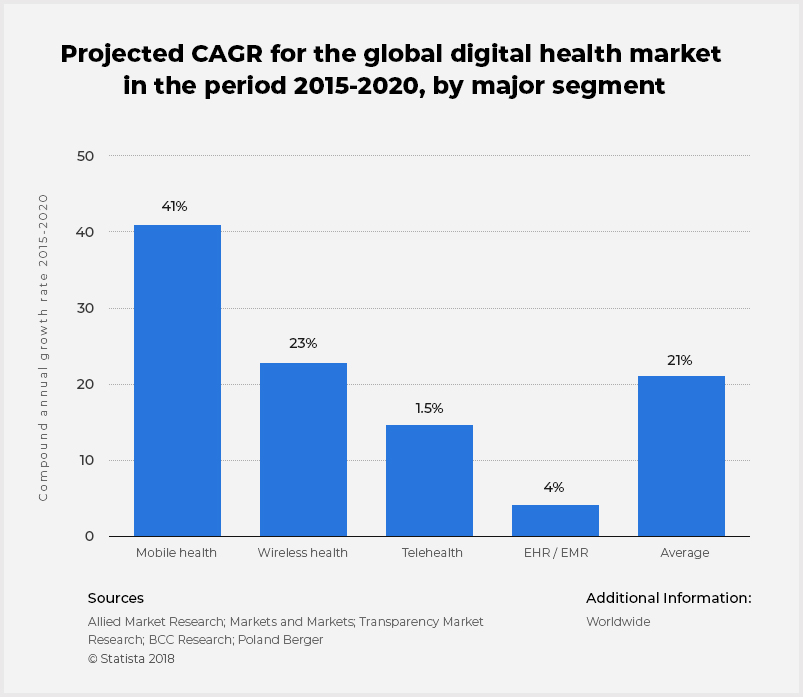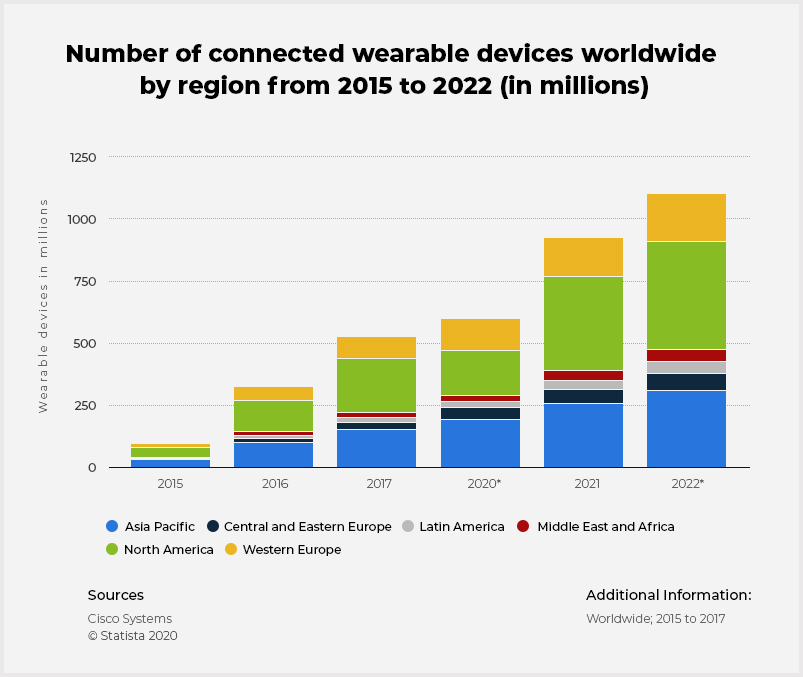The global digital health market is estimated to reach over $200 billion by the end of 2020, with a projected 41% CAGR (compound annual growth rate) for the mobile health market as per Statista. Another statistic shows a forecast of the medical mobile apps market worldwide to reach over $11 billion by 2025. This projection was almost five times the estimated market size in 2017.

With the ease of accessibility and convenience, healthcare mobile apps are helping people lead healthy lives. By leveraging healthcare apps on iOS and Android devices, patients can now stay in touch with their healthcare service provider 24×7.
As people continue to follow healthcare mobile app trends, it has significantly eased the burden on the hospitals, improved patient monitoring, and provided better ways to connect with doctors. The mobile healthcare market, as a result, has prospered over the years.
To illustrate the importance of digital technology in healthcare, let’s look at the ten key healthcare mobile app trends in 2020.
Patient-Generated Health Data (PGHD)
As the name suggests, PGHD is a health-related data characterizing the history of a patient, including details of disease (if any) and recovery. The abundant data is what mobile app users themselves create or record almost unknowingly. It is a healthcare mobile app trend that offers a comprehensive picture of patients’ health, filling gaps in information.
PGHD mainly includes symptoms of the disease, treatment history (with health details), details on the healing process, biometric data, lifestyle, habits, and more. A careful analysis of this data can significantly reduce patients’ visits to a clinic.
Wearable Devices
Smart wearable devices offer constant monitoring of health at all times. For instance, Fitbit, with its impressive line-up of smartwatches and wireless-enabled wearable devices, measure personal metrics (like steps walked, quality of sleep, heart rate, and more) with ease. Wearable devices in North America are projected to reach 439 million connections closely followed by the Asia Pacific region in 2022.

From breathing, chest movement to heart rate, wearable devices have various sensors to track and monitor these health parameters. This makes them an attractive proportion of healthcare mobile app development.
Telemedicine and Telehealth Apps
With a 120% growth rate, Telemedicine is among the fastest-growing segments in healthcare IT. Estimated to reach $113 billion by 2025, Telemedicine is a current healthcare mobile app trend. As the name suggests, Telemedicine involves the use of technology to exchange medical information. It is convenient, cost-effective, and offers better access to reliable doctors reducing absenteeism.
Telehealth apps like “doctor on demand” or “HealthTap” provide video calls with board-certified doctors right away or by appointment to patients. Based on the diagnosis, the doctor will send you a digital prescription as well. Healthcare apps like these have been quite popular among patients as the majority of people prefer to schedule a video call over clinic visits.
Communication Channels
With an effective communication process, the chances of treatment success also improve. There are several communication channels like instant messaging, real-time video calls, emergency calls (SOS signal), and more. Lately, speech recognition has become the communication channel that is forecasted to dominate the digital healthcare industry. By leveraging these effective communication channels in a mobile app, businesses offer real-time support to patients.
As quality user feedback becomes crucial, medical application experts cite improvement in communication channels – a new trend in the healthcare industry.
Geolocation
Geolocation is one of the main features in healthcare mobile applications and here’s why:
- Geolocation allows a patient to locate the address of nearby hospitals, pharmacies, clinics and more
- In case a person gets injured at an unknown location, the feature helps him/her make an emergency call
- Provide medical news and information regarding emergencies (such as areas of the hotspot during the COVID-19 pandemic), and more
The active use of geolocation in healthcare mobile apps is crucial during this pandemic as it can help fight against the spread of the virus. For instance, the Government of India recently launched Aarogya Setu – a mobile app that uses geolocation and Bluetooth data to alert users if there’s a COVID-19 patient nearby.
Similar approaches from the Singapore Government and MIT with TraceTogether and Private Kit: Safe Paths app highlights the active use of geolocation – a healthcare mobile app trend in 2020. To develop an app for contact tracing in your area, check out our practical guide on healthcare mobile app development.
Contact Tracing
To contain the emerging cluster of coronavirus infections and restore normalcy, experts around the world suggest the use of contact tracing technology. When combined with a mobile application, contact-tracing allows silent tracking of individuals and notifies the user if any of their contacts have been tested COVID-19 positive.
For instance, the Government of India recently launched Aarogya Setu – a mobile app that uses geolocation and Bluetooth data to alert users if there’s a COVID-19 patient nearby. Similar approaches from the Singapore Government and MIT with TraceTogether and Private Kit: Safe Paths app highlights the active use of contact-tracing – a healthcare mobile app trend in 2020. To develop an app for contact tracing in your area, check out our practical guide on healthcare mobile app development.
Data Protection
The biggest challenge for healthcare mobile apps is the protection of sensitive patient data from unauthorized access. As patients and health care workers continuously use mHealth apps to collect and share health-related information, special attention must be given to mobile data security. With popular mHealth apps like HealthTap or Doctor On Demand being HIPAA compliant, patient’s data is restricted from unauthorized access. Moreover, as new technologies emerge, data protection is bound to improve emerging as a new trend in healthcare app development.
mHealth Payment Services
Arranging cash and making the payment during a medical emergency is no longer an issue. With the widespread adoption of mobile payments, transaction processing has been enabling easier access to healthcare services, especially during emergency situations.
Brands like Instamed and Cedar Pay are offering secure and hassle-free mobile payment solutions to the patients by partnering with healthcare service providers. There are several payment methods like mobile wallets, Near Field Communication (NFC), payment portals, and more that can be integrated into a healthcare mobile app.
Internet of Things (IoT)
IoT is widely used in healthcare systems to collect the necessary information from connected devices and transfer it to the healthcare service provider. Here, the connected devices mostly include fitness trackers in wearable devices allowing physicians to easily monitor the vitals of a patient.
It can alert the service provider if something happens to the patient or crosses the threshold value. A recent study revealed the use of the Apple Watch app to monitor and assess patients with depression. It demonstrates how IoT helps in dealing with depression and provides insight into a patient’s conditions.
Cloud-based solutions
Integrating Electronic medical records (EMR) and Electronic health records (EHR) with cloud-based solutions allow easier access to patient records, medical bills, insurance plans, and more. Cloud-based solutions make healthcare mobile app services more accessible. With cloud-based infrastructure, the healthcare service provider delivers better data security at a lower cost.
Conclusion
Amid the COVID-19 pandemic, the importance of healthcare mobile app is increasing exponentially. It eases the burden on healthcare workers by connecting patients with doctors online and even offers contact tracing to prevent the spread of the virus.
With the Apple-Google partnership on COVID-19 contact tracing technology, efforts are made to offer a comprehensive solution. At FATbit Technologies, we strive to deliver healthcare mobile applications for healthcare businesses while implementing the latest trends to ease the burden on hospitals and patients. For a complete guide on healthcare mobile app development, click here.





Comments (9)
 Shubham
Shubham
 FATbit Chef
FATbit Chef
 Kan Smith
Kan Smith
 FATbit Chef
FATbit Chef
 Mobile App Development Company
Mobile App Development Company
 FATbit Chef
FATbit Chef
 Kulmohan Singh
Kulmohan Singh
 Elena Bennet
Elena Bennet
 Jay
Jay
Thanks a lot for sharing this amazing blog with us. Please keep sharing such great piece of article so we can get more knowledge about this type of topic.
Hello Shubham,
Thank you so much for your appreciation. Stay tuned for more insights.
Regards,
Team FATbit
Great Article
Hello Kan,
Thank you so much for your appreciation. Stay tuned for more insights.
Best Regards,
Team FATbit
Thanks for the informative Guide
Hello,
Thank you so much for your appreciation. Stay tuned for insights.
Regards,
Team FATbit
Smartwatches and fitness trackers are the biggest trend in the healthcare industry. I request you to please provide more articles on them.
A great piece that sheds much-needed light on merging technology and its impact on the business as there are many new details you posted here. The app design trends of 2021 all follow the shared goal of making app usage more comfortable, engaging and pleasurable; here you need proper development skills and experience. However, the details you mention here would be very much helpful for the beginner.
Great piece of Info, Sahil. Will add up one thing Healthcare Apps will revolutionize in 2021. Users no longer have to remember or note down their readings. The App even displays the high/low/controlled level of the blood sugar &a blood pressure that the person has.